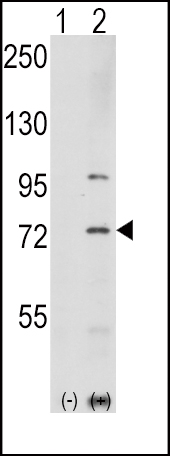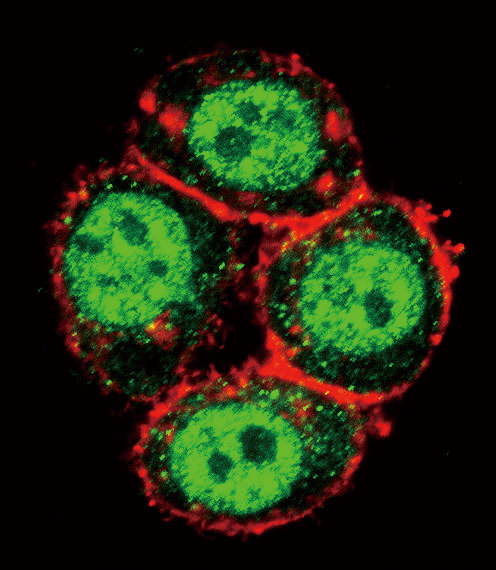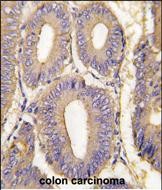PAK1 Antibody (T423)
Affinity Purified Rabbit Polyclonal Antibody (Pab)
- 产品详情
- 实验流程
- 背景知识
Application
| WB, IF, IHC-P, E |
|---|---|
| Primary Accession | Q13153 |
| Other Accession | Q62829, Q61036, O75914, Q64303, Q29502, Q8CIN4, Q13177, P35465, O88643, Q08E52 |
| Reactivity | Human |
| Predicted | Bovine, Mouse, Rat, Rabbit |
| Host | Rabbit |
| Clonality | Polyclonal |
| Isotype | Rabbit IgG |
| Calculated MW | 60647 Da |
| Antigen Region | 401-430 aa |
| Gene ID | 5058 |
|---|---|
| Other Names | Serine/threonine-protein kinase PAK 1, Alpha-PAK, p21-activated kinase 1, PAK-1, p65-PAK, PAK1 |
| Target/Specificity | This PAK1 antibody is generated from rabbits immunized with a KLH conjugated synthetic peptide between 401-430 amino acids from human PAK1. |
| Dilution | WB~~1:1000 IF~~1:10~50 IHC-P~~1:100~500 E~~Use at an assay dependent concentration. |
| Format | Purified polyclonal antibody supplied in PBS with 0.09% (W/V) sodium azide. This antibody is purified through a protein A column, followed by peptide affinity purification. |
| Storage | Maintain refrigerated at 2-8°C for up to 2 weeks. For long term storage store at -20°C in small aliquots to prevent freeze-thaw cycles. |
| Precautions | PAK1 Antibody (T423) is for research use only and not for use in diagnostic or therapeutic procedures. |
| Name | PAK1 {ECO:0000303|PubMed:8805275, ECO:0000312|HGNC:HGNC:8590} |
|---|---|
| Function | Protein kinase involved in intracellular signaling pathways downstream of integrins and receptor-type kinases that plays an important role in cytoskeleton dynamics, in cell adhesion, migration, proliferation, apoptosis, mitosis, and in vesicle-mediated transport processes (PubMed:10551809, PubMed:11896197, PubMed:12876277, PubMed:14585966, PubMed:15611088, PubMed:17726028, PubMed:17989089, PubMed:30290153, PubMed:17420447). Can directly phosphorylate BAD and protects cells against apoptosis (By similarity). Activated by interaction with CDC42 and RAC1 (PubMed:8805275, PubMed:9528787). Functions as a GTPase effector that links the Rho-related GTPases CDC42 and RAC1 to the JNK MAP kinase pathway (PubMed:8805275, PubMed:9528787). Phosphorylates and activates MAP2K1, and thereby mediates activation of downstream MAP kinases (By similarity). Involved in the reorganization of the actin cytoskeleton, actin stress fibers and of focal adhesion complexes (PubMed:9032240, PubMed:9395435). Phosphorylates the tubulin chaperone TBCB and thereby plays a role in the regulation of microtubule biogenesis and organization of the tubulin cytoskeleton (PubMed:15831477). Plays a role in the regulation of insulin secretion in response to elevated glucose levels (PubMed:22669945). Part of a ternary complex that contains PAK1, DVL1 and MUSK that is important for MUSK-dependent regulation of AChR clustering during the formation of the neuromuscular junction (NMJ) (By similarity). Activity is inhibited in cells undergoing apoptosis, potentially due to binding of CDC2L1 and CDC2L2 (PubMed:12624090). Phosphorylates MYL9/MLC2 (By similarity). Phosphorylates RAF1 at 'Ser- 338' and 'Ser-339' resulting in: activation of RAF1, stimulation of RAF1 translocation to mitochondria, phosphorylation of BAD by RAF1, and RAF1 binding to BCL2 (PubMed:11733498). Phosphorylates SNAI1 at 'Ser- 246' promoting its transcriptional repressor activity by increasing its accumulation in the nucleus (PubMed:15833848). In podocytes, promotes NR3C2 nuclear localization (By similarity). Required for atypical chemokine receptor ACKR2-induced phosphorylation of LIMK1 and cofilin (CFL1) and for the up-regulation of ACKR2 from endosomal compartment to cell membrane, increasing its efficiency in chemokine uptake and degradation (PubMed:23633677). In synapses, seems to mediate the regulation of F-actin cluster formation performed by SHANK3, maybe through CFL1 phosphorylation and inactivation (By similarity). Plays a role in RUFY3-mediated facilitating gastric cancer cells migration and invasion (PubMed:25766321). In response to DNA damage, phosphorylates MORC2 which activates its ATPase activity and facilitates chromatin remodeling (PubMed:23260667). In neurons, plays a crucial role in regulating GABA(A) receptor synaptic stability and hence GABAergic inhibitory synaptic transmission through its role in F-actin stabilization (By similarity). In hippocampal neurons, necessary for the formation of dendritic spines and excitatory synapses; this function is dependent on kinase activity and may be exerted by the regulation of actomyosin contractility through the phosphorylation of myosin II regulatory light chain (MLC) (By similarity). Along with GIT1, positively regulates microtubule nucleation during interphase (PubMed:27012601). Phosphorylates FXR1, promoting its localization to stress granules and activity (PubMed:20417602). Phosphorylates ILK on 'Thr-173' and 'Ser-246', promoting nuclear export of ILK (PubMed:17420447). |
| Cellular Location | Cytoplasm. Cell junction, focal adhesion. Cell projection, lamellipodium. Cell membrane. Cell projection, ruffle membrane. Cell projection, invadopodium. Nucleus, nucleoplasm. Chromosome. Cytoplasm, cytoskeleton, microtubule organizing center, centrosome Note=Colocalizes with RUFY3, F-actin and other core migration components in invadopodia at the cell periphery (PubMed:25766321) Recruited to the cell membrane by interaction with CDC42 and RAC1 Recruited to focal adhesions upon activation. Colocalized with CIB1 within membrane ruffles during cell spreading upon readhesion to fibronectin. Upon DNA damage, translocates to the nucleoplasm when phosphorylated at Thr-212 where is co-recruited with MORC2 on damaged chromatin (PubMed:23260667). Localization to the centrosome does not depend upon the presence of gamma-tubulin (PubMed:27012601) Localization of the active, but not inactive, protein to the adhesions and edge of lamellipodia is mediated by interaction with GIT1 (PubMed:11896197). {ECO:0000250|UniProtKB:P35465, ECO:0000269|PubMed:11896197, ECO:0000269|PubMed:23260667, ECO:0000269|PubMed:25766321, ECO:0000269|PubMed:27012601} |
| Tissue Location | Overexpressed in gastric cancer cells and tissues (at protein level) (PubMed:25766321). |
For Research Use Only. Not For Use In Diagnostic Procedures.
Provided below are standard protocols that you may find useful for product applications.
BACKGROUND
PAK1, a member of the STE20 subfamily of Ser/Thr protein kinases, acts on a variety of targets. It is likely to be the GTPase effector that links the Rho-related GTPases to the JNK MAP kinase pathway. Activity is inhibited in cells undergoing apoptosis, potentially due to binding of CDC2L1 and CDC2L2. The protein interacts tightly with GTP-bound but not GDP-bound CDC42/P21 and RAC1. PAK1 binds to the caspase-cleaved p110 isoform of CDC2L1 and CDC2L2, p110C, but not the full-length proteins. It is a component of cytoplasmic complexes, which also contain PXN, ARHGEF6 and GIT1. The protein is autophosphorylated when activated by CDC42/p21. Structurally, the PAK1 contains 1 CRIB domain.
REFERENCES
Chen, S., et al., J. Biol. Chem. 278(22):20029-20036 (2003).
Sells, M.A., et al., Curr. Biol. 7(3):202-210 (1997).
Brown, J.L., et al., Curr. Biol. 6(5):598-605 (1996).
终于等到您。ABCEPTA(百远生物)抗体产品。
点击下方“我要评价 ”按钮提交您的反馈信息,您的反馈和评价是我们最宝贵的财富之一,
我们将在1-3个工作日内处理您的反馈信息。
如有疑问,联系:0512-88856768 tech-china@abcepta.com.























 癌症的基本特征包括细胞增殖、血管生成、迁移、凋亡逃避机制和细胞永生等。找到癌症发生过程中这些通路的关键标记物和对应的抗体用于检测至关重要。
癌症的基本特征包括细胞增殖、血管生成、迁移、凋亡逃避机制和细胞永生等。找到癌症发生过程中这些通路的关键标记物和对应的抗体用于检测至关重要。 为您推荐一个泛素化位点预测神器——泛素化分析工具,可以为您的蛋白的泛素化位点作出预测和评分。
为您推荐一个泛素化位点预测神器——泛素化分析工具,可以为您的蛋白的泛素化位点作出预测和评分。 细胞自噬受体图形绘图工具为你的蛋白的细胞受体结合位点作出预测和评分,识别结合到自噬通路中的蛋白是非常重要的,便于让我们理解自噬在正常生理、病理过程中的作用,如发育、细胞分化、神经退化性疾病、压力条件下、感染和癌症。
细胞自噬受体图形绘图工具为你的蛋白的细胞受体结合位点作出预测和评分,识别结合到自噬通路中的蛋白是非常重要的,便于让我们理解自噬在正常生理、病理过程中的作用,如发育、细胞分化、神经退化性疾病、压力条件下、感染和癌症。








